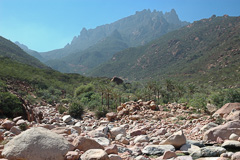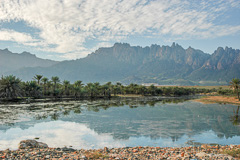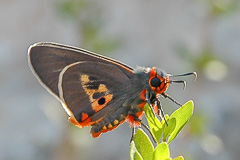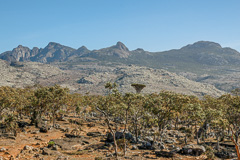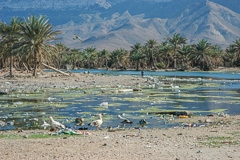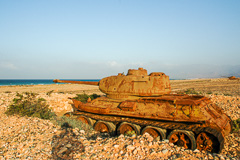Birding Sites
This report is divided into three sections:
Section 1 - Introduction, logistics general information and itinerary.
Section 2 - Birding sites.
Section 3 - Systematic species list.
If the sole aim would be seeing the Socotra endemic species it would be necessary to visit only two or three sites. However, with a week, most birders should be able to explore all the better birding sites on the island and in doing so contribute to the understanding of the distribution of Socotra's birds, about which much is still to be discovered. On a one week trip it is still likely that good coverage will turn up one or two new species for the island's list. Those with limited time should concentrate on Wadi Ayhaft National Park, Deham and Dixem.
|
The paving of roads on Socotra has accelerated recently. This has made access, especially to the central highlands, much easier. Other roads are being cut and paved, and we passed several road construction camps and witnessed extensive new road cuttings and culvert construction gangs. One of the strangest roads is the dual carriageway ring road around Hadibu, which itself still has dirt streets. Much change will be evident over the coming years.
1. Hadibu Area
Hadibu lies on a small plain bounded to the north by sea, and mountains on the remaining sides. The town itself has only the small, heavily-polluted, palm-lined Khor Sirhin which attracts a few roosting gulls and terns near the beach. This area is also the last stand of the few remaining House Crow on Socotra, which are thankfully being slowly, but surely, eradicated.
|
2. Wadi Dihazafaq and Qrahan Plain
Wadi Dihazafaq (sometimes referred to as Wadi Denegen), the closest well-vegetated wadi to Hadibu, contains the commoner and more widespread endemics. From the Hadibu bypass take the track (waypoint 010) 500 metres after the large wadi crossing and follow it through palm plantations in a south-easterly direction for around 6.4 km. As you approach, from some distance, you see the wadi entrance before you. Several tracks branch off, but the scale of the wadi makes finding it easy. The track terminates by a house, conveniently beneath a large shady tree, just after the wadi entrance, where you can park and continue on foot (waypoint 020). |
|
Socotra Sunbird, and Socotra Sparrow are common in this area, and Socotra Golden-winged Grosbeak and Socotra Starling are both present, though the later is well outnumbered by the ubiquitous Somali Starling.
|
We spent only a couple of hours here and walked no more than a kilometre up the wadi. However, it would be possible to continue for several kilometres, and potentially Socotra Warbler should occur. The wadi, as well as the surrounding open areas, holds Nubian Nightjar, though we tried on several occasions and failed. Between the palms of Wadi Sirhin and Wadi Dihazafaq the track passes mainly through Croton Croton socotranus scrub. However, to the east, toward Wadi Shoq, is a large open area, known as Qrahan Plain, which regularly holds Cream-coloured Courser.
3. Wadi Shoq
See map above. Wadi Shoq, lying to the east of the Qrahan plain, has a number of date palm plantations which are a good for Socotra Scops Owl. The wadi starts directly from the road (waypoint 031), a few kilometres from Hadibu, immediately before the road snakes left around the mountain. Only the first 500 metres or so of the wadi has palms; thereafter it opens into rocky open areas containing few birds. As in most of the palm groves around Hadibu the scops owl can be heard readily in the evening, as usually commences calling before dusk. Some of the taller palms held wintering Black-crowned Night Heron, a relatively scarce species on Socotra.
4. Khor Sirhin
See map above. Affectionately known as "Hadibu Marsh", and sometimes Khor Erhina, this small khor just east of town, is within walking distance and makes an attractive stop for a an hour or so. Although small, a good variety of species have been recorded, and on both our visits we made interesting discoveries. In winter a few ducks are often present, and the shallow edges have waders, egrets, and herons in addition to passerines such as wagtails. It is recommended to circumnavigate the khor, although this will involve weaving in and out of palm plantations at the northern end, to check for migrants or roosting birds in the palms. We recorded Yellow Bittern, Indian Pond Heron and Black-crowned Night Heron. On the slopes above the palms a few garden plots contain vegetable patches which should attract migrants at the appropriate time. |
5. Khors west of Hadibu
See Hadibu Area map above. Two small sandy khors west of Hadibu are passed en route to the airport - the first just before the village of Qadab, the second a couple of kilometres after. Both are without vegetation, so only waders, seabirds, and waterbirds might be expected. We did however record Socotra's first Slender-billed Gull here.
6. Deham
|
The saline flats and low scrub just behind the village of Deham is, as far as I am aware, the only site close to Hadibu where Socotra Cisticola can be readily found. The area must be under threat from marauding goats and camels. Certainly we saw no similar habitat along the coast between Hadibu and Deham. The Socotra Cisticola is readily found here, as it displays from low bush tops. The small adjacent khor and beach hold the usual collection of gulls, terns and a few waders. Access is directly from the main coastal road, 7.8 km west of the airport turn.
7. Wadi Ayhaft National Park
|
This excellent, and verdant wadi lies about an hour's drive from Hadibu. From Hadibu, take the main coastal highway toward the airport, and then the track 8.2 kilometres from the start of the ring road. This track crosses a small wadi and skirts a village before a major fork after 1.9 km (waypoint 048) where you should turn left. After a further 1.1 kilometres a park sign is seen on the right. This rough track, which gets progressively worse as you ascend, runs along the wadi, crossing the wadi floor regularly, to the end of the road at around a further six kilometres. Higher sections will almost certainly be inaccessible after heavy rains. The habitat contains good numbers of large trees, and this is easily the best locality we visited for finding Socotra Golden-winged Grosbeak, and well as Socotra Sunbird in good numbers. Socotra Bunting is sometimes recorded from higher sections of the track. The road terminates at a small settlement, around which Socotra Warbler can be found, although it does occur in small numbers anywhere along the access road. Socotra Starling is also present in the area, but not common. A few pairs of Socotra Buzzard are regularly seen and heard. We found the very impressive Socotra Island Blue Baboon Spider Monocentropus balfouri, and the equally stunning One-pip Policeman Coeliades anchises here. |
8. Dixem, Wadi Zerig and the Central highway
|
The limestone hills and central highlands, particularly on the Dixem plateau, are the stronghold of the rare and localised Socotra Bunting, which is, without doubt, the most difficult of the endemics to locate. The paving of the cross-island route has made access to Dixem relatively straightforward, so weather permitting it should be possible to find the bunting on a day trip from Hadibu. However, with its rugged landscape, Dragon's Blood Trees and cooler climate, this makes an excellent camping trip for those with time and inclination.
Additionally, this is the stronghold of the Socotra Starling, which is relatively common here. From Hadibu, take the coast road toward Qalansiyah, passing the airport. From the airport turn-off, continue 12.5 km and turn left (waypoint 094) - well signposted to Dixem. After a further three kilometres the road starts to ascend the escarpment, with excellent views across the northern plains. The Croton scrub here forms a rather monotonous habitat, but holds both Socotra Golden-winged Grosbeak and Socotra Warbler. We stopped at random, 6.3 km from the turnoff and had a party of at least five cisticolas. At 23.4 km from the turn off (waypoint 090), a rough track leads off left to Dixem, terminating after 2.2 kilometres from where it is necessary to continue on foot. I would strongly recommend using a GPS from this point, as the footpath, which leads to a few goat herders huts, rapidly disappears. The whole area, comprised of limestone hills and grassy valleys, is rather confusing, so directions cannot be reliably given; hence the use of GPS coordinates. From the parking area, looking to the northeast, across the valley, you see a prominent, domed, limestone hillside, transacted by a few valleys which are the areas to search for the bunting. They feed on the grassy hillsides both in the valleys and on the tops. During our visit we walked around the southern edge initially, as this was where the buntings had been seen the previous week. |
This proved unsuccessful, and we spent further time around the far side before eventually finding several individuals (waypoints BUNT and VIEW). We noted that the birds were not as obvious as illustrated in the field guide, and Cinnamon-breasted Rock Bunting is common in the area.
Returning to the road and turning south toward the south coast will, after 5.3 km, bring you to Wadi Zerig.
|
This was the only wadi we encountered with a good cover of rushes, and a walk eastward along it produced Bluethroat, Common Quail and Common Snipe – a site well worth checking for those with time.
9. Khor Qalansiyah and Ditwah Protected Area
|
As these two adjacent sites are located on the extreme western side of Socotra, an overnight camp is recommended. However, once the paved road from Hadibu to Qalansiyah is complete the journey would be less than two hours. When travelling from Hadibu, the turning off the main coast road to Qalansiyah is 16.3 km after the Dixem turn off. Currently this windy mountain road is paved for 9.4 km, with the remaining 20 kilometres rough and dusty. On approach to Qalansiyah village the road crosses the small wadi that feeds Khor Qalansiyah, and after a further 1.3 km, forks, just before the large new, flashy governor's office. Turning right at the fork takes you past the office and after 1.5 km to the shore of the coastal lagoon of Ditwah Protected Area.
With permission, it is possible to camp on the beach, where some palm shelters and toilets have been provided by the local Environmental Protection Agency. Basic food can be purchased in Qalansiyah or brought from Hadibu. The tidal flats at Ditwah are very scenic and the beach unspoilt and beautiful. Waders are present in good numbers on the lagoon. In stark contrast to the beauty of Ditwah is the polluted Khor Qalansiyah, situated behind the beach to the south of the village. Despite several clean-up exercises by the Environment Protection Agency, the khor is still treated as a dustbin by the local inhabitants, and must rate as the worst eyesore on Socotra – maybe equalling the khor in central Hadibu. Despite the mess, the khor attracts numerous gulls, terns, waders and a few passerines. We recorded Collared Pratincole as well as Socotra's first Pallas's Gull. A walk around the khor will take no more than an hour. Offshore the good fishing attracts hundreds of Socotra Cormorant and Brown Booby. Qalansiyah was the only place on Socotra where the young kids were objectionable, and they appear to have developed a reputation for it. Small fishing boats for offshore trips and journeys to Shoep can be arranged by talking to the fishermen on the beach. |
10. Shoep
Shoep is a largish khor with a fair amount of mangrove still remaining. The long sandy beach is beautiful and, due to access difficulties, rarely visited. The rocky edges of the khor mean only a few waders are present, and we were surprised to find no ducks and very few water birds on our visit – Indian Pond Heron being a notable record. The mangroves are a good locality for Socotra Warbler. Socotra Cisticola occurs in low densities in the surrounding low vegetation, which is very arid and unlike that at Deham where this species is more readily found.
Shoep is only accessible by sea from Qalansiyah, a journey of 21 kilometres and best attempted in the morning, when the sea is calm. Any wind makes seas on this exposed western side very rough. The journey from Qalansiyah takes about an hour, but try to hire a boat with larger motor if possible (40 HP should be possible). The trip passes stunning, towering cliffs which hold a number of breeding seabirds including Jouanin's Petrel. Brown Booby are very common as are Socotra Cormorant. Well offshore, nearer Shoep, it's possible to make out some isolated rocky islets where Masked Booby breed, and a few might be seen en route.
11. Khors East of Hadibu
East of Hadibu, three small khors are passed en route to Khor Quryah National Reserve. Their small size and steep sides makes them generally unattractive to birds, but surprisingly Khor Dilish held Socotra's first African Sacred Ibis.
|
The first khor, Khor Shoq is passed just after Wadi Shoq, 2.9 km east of Khor Sirhin. The next Khor is Khor Dilish, a further 9.4 km, with finally Khor Dibni 2.5 km beyond Dilish.
12. Khor Quryah National Reserve
The largest khor on Socotra, Khor Quryah sometimes attracts good numbers of ducks and waders. The road from Hadibu is currently being paved, and once completed will cut the travel time considerably. A rough track braches off the main Hadibu to South Coast road (waypoint 167) about six kilometres before Quryah, and continues to the village where it eventually crosses the khor on a low causeway (waypoint 165).
|
Scanning the two arms of water to the south may reveal ducks if present. Walking through the palm plantations leads to the eastern side of the khor where extensive flats are exposed at low tide.
13. Khor Ghuba
Khor Ghuba lays a couple of kilometres from the highway, around six kilometres west of the Dixem turn-off. From the Dixem junction (waypoint 94) continue west for 6.1 km (passing some rusting soviet tanks en route) and take the track north. After less than a kilometre you will see the small khor on the right, and the beach is reached after 1.8 km. It is possible to drive between the sea and khor and loop back to the main road. |
|
14. The Nowged Plain and the South Coast
The towering escarpment across the southern edge of Socotra creates the arid Nowged Plain. With little vegetation and no standing fresh water, birds are not plentiful. Wadis that cross the plain definitely have Nubian Nightjar, but they appear as rare here as anywhere. We investigated some palms, tamarisk scrub and salt pans east of Abetar village. Take plenty of fresh water when travelling in this area.
GPS waypoints
| Name | Lat/Long hddd°mm.mmm' | |
| 1 | N12 38.931 E54 00.795 | |
| 2 | N12 39.020 E54 01.065 | |
| 3 | N12 39.020 E54 01.109 | |
| 4 | N12 39.053 E54 01.108 | |
| 5 | N12 39.054 E54 01.128 | |
| 6 | N12 38.661 E54 01.309 | |
| 7 | N12 38.534 E54 01.422 | |
| 8 | N12 38.667 E54 01.590 | |
| 9 | N12 38.744 E54 01.678 | |
| 10 | N12 38.911 E54 01.886 | |
| 11 | N12 38.698 E54 02.413 | |
| 12 | N12 38.652 E54 02.566 | |
| 13 | N12 38.724 E54 02.753 | |
| 14 | N12 38.421 E54 03.144 | |
| 15 | N12 38.040 E54 03.410 | |
| 16 | N12 37.618 E54 03.660 | |
| 17 | N12 37.585 E54 03.783 | |
| 18 | N12 37.376 E54 03.891 | |
| 19 | N12 37.234 E54 03.857 | |
| 20 | N12 36.979 E54 03.807 | |
| 21 | N12 38.730 E54 02.863 | |
| 22 | N12 38.743 E54 02.874 | |
| 23 | N12 38.822 E54 03.111 | |
| 24 | N12 39.139 E54 03.192 | |
| 25 | N12 39.249 E54 03.184 | |
| 26 | N12 39.264 E54 03.184 | |
| 27 | N12 39.286 E54 03.183 | |
| 28 | N12 39.436 E54 03.137 | |
| 29 | N12 39.837 E54 03.025 | |
| 30 | N12 39.848 E54 03.020 | |
| 31 | N12 39.857 E54 03.010 | |
| 32 | N12 39.599 E54 02.270 | |
| 33 | N12 39.597 E54 02.231 | |
| 34 | N12 39.551 E54 01.915 | |
| 35 | N12 39.070 E54 02.053 | |
| 36 | N12 38.393 E54 01.224 | |
| 37 | N12 38.772 E54 00.444 | |
| 38 | N12 38.284 E53 57.295 | |
| 39 | N12 38.170 E53 57.036 | |
| 40 | N12 38.238 E53 56.242 | |
| 41 | N12 37.558 E53 55.028 | |
| 42 | N12 36.409 E53 51.378 | |
| 43 | N12 36.326 E53 51.534 | |
| 44 | N12 38.034 E53 56.894 | |
| 45 | N12 37.899 E53 56.609 | |
| 46 | N12 37.738 E53 56.364 | |
| 47 | N12 37.716 E53 56.175 | |
| 48 | N12 37.648 E53 55.962 | |
| 49 | N12 37.412 E53 56.051 | |
| 50 | N12 37.205 E53 56.164 | |
| 51 | N12 37.166 E53 56.251 | |
| 52 | N12 37.139 E53 56.539 | |
| 53 | N12 37.125 E53 56.711 | |
| 54 | N12 37.091 E53 56.912 | |
| 55 | N12 36.905 E53 57.500 | |
| 56 | N12 36.692 E53 57.885 | |
| 57 | N12 36.704 E53 58.223 | |
| 58 | N12 36.719 E53 58.519 | |
| 59 | N12 36.698 E53 58.667 | |
| 60 | N12 36.599 E53 58.757 | |
| 61 | N12 36.515 E53 59.199 | |
| 62 | N12 36.595 E53 59.293 | |
| 63 | N12 36.595 E53 59.292 | |
| 64 | N12 36.602 E53 59.358 | |
| 65 | N12 36.392 E53 59.523 | |
| 66 | N12 39.582 E54 02.211 | |
| 67 | N12 39.878 E54 03.089 | |
| 68 | N12 39.936 E54 03.702 | |
| 69 | N12 39.796 E54 03.808 | |
| 70 | N12 32.525 E53 59.279 | |
| 71 | N12 32.474 E53 59.205 | |
| 72 | N12 32.421 E53 59.152 | |
| 73 | N12 32.386 E53 59.104 | |
| 74 | N12 32.338 E53 58.971 | |
| 75 | N12 32.255 E53 58.882 | |
| 76 | N12 32.163 E53 58.827 | |
| 77 | N12 32.123 E53 58.831 | |
| 78 | N12 32.113 E53 58.887 | |
| 79 | N12 32.113 E53 58.765 | |
| 80 | N12 32.126 E53 58.740 | |
| 81 | N12 32.106 E53 58.666 | |
| 82 | N12 32.062 E53 58.634 | |
| 83 | N12 32.022 E53 58.545 | |
| 84 | N12 31.955 E53 58.335 | |
| 85 | N12 31.840 E53 58.205 | |
| 86 | N12 31.737 E53 58.167 | |
| 87 | N12 31.597 E53 58.131 | |
| 88 | N12 31.433 E53 58.128 | |
| 89 | N12 31.359 E53 58.076 | |
| 90 | N12 31.274 E53 57.985 | |
| 91 | N12 31.017 E53 54.518 | |
| 92 | N12 31.319 E53 53.088 | |
| 93 | N12 34.098 E53 49.299 | |
| 94 | N12 35.676 E53 49.138 | |
| 95 | N12 35.568 E53 50.722 | |
| 96 | N12 35.851 E53 51.250 | |
| 97 | N12 36.415 E53 51.840 | |
| 98 | N12 37.547 E53 55.015 | |
| 99 | N12 38.290 E53 56.075 | |
| 100 | N12 38.281 E53 57.231 | |
| 101 | N12 38.794 E54 00.415 | |
| 102 | N12 38.791 E54 02.513 | |
| 103 | N12 39.555 E53 40.524 | |
| 104 | N12 39.719 E53 40.321 | |
| 105 | N12 39.809 E53 39.894 | |
| 106 | N12 38.913 E53 38.018 | |
| 107 | N12 38.245 E53 37.582 | |
| 108 | N12 37.553 E53 36.606 | |
| 109 | N12 37.912 E53 35.529 | |
| 110 | N12 38.222 E53 33.914 | |
| 111 | N12 39.618 E53 30.840 | |
| 112 | N12 39.968 E53 29.705 | |
| 113 | N12 40.976 E53 29.624 | |
| 114 | N12 41.142 E53 29.623 | |
| 115 | N12 41.376 E53 29.454 | |
| 116 | N12 41.515 E53 29.612 | |
| 117 | N12 41.628 E53 29.887 | |
| 118 | N12 41.745 E53 30.124 | |
| 119 | N12 41.862 E53 30.006 | |
| 120 | N12 41.352 E53 29.034 | |
| 121 | N12 41.302 E53 29.127 | |
| 122 | N12 41.314 E53 29.180 | |
| 123 | N12 41.352 E53 29.181 | |
| 124 | N12 41.399 E53 29.220 | |
| 125 | N12 41.426 E53 29.266 | |
| 126 | N12 41.440 E53 29.321 | |
| 127 | N12 41.453 E53 29.380 | |
| 128 | N12 41.460 E53 29.421 | |
| 129 | N12 41.488 E53 29.494 | |
| 130 | N12 41.514 E53 29.642 | |
| 131 | N12 41.582 E53 29.791 | |
| 132 | N12 41.654 E53 29.999 | |
| 133 | N12 41.670 E53 30.103 | |
| 134 | N12 41.702 E53 30.130 | |
| 135 | N12 39.837 E53 41.662 | |
| 136 | N12 38.492 E53 43.054 | |
| 137 | N12 37.279 E53 44.672 | |
| 138 | N12 36.876 E53 45.791 | |
| 139 | N12 36.434 E53 45.955 | |
| 140 | N12 36.562 E53 46.051 | |
| 141 | N12 36.610 E53 46.122 | |
| 142 | N12 36.630 E53 46.173 | |
| 143 | N12 36.638 E53 46.233 | |
| 144 | N12 36.655 E53 46.529 | |
| 145 | N12 36.704 E53 46.603 | |
| 146 | N12 36.704 E53 46.841 | |
| 147 | N12 36.154 E53 47.735 | |
| 148 | N12 36.022 E53 48.103 | |
| 149 | N12 39.541 E54 01.915 | |
| 150 | N12 39.594 E54 02.249 | |
| 151 | N12 39.935 E54 03.703 | |
| 152 | N12 40.798 E54 04.904 | |
| 153 | N12 41.664 E54 05.974 | |
| 154 | N12 41.704 E54 06.842 | |
| 155 | N12 41.314 E54 07.654 | |
| 156 | N12 41.185 E54 07.807 | |
| 157 | N12 40.103 E54 08.316 | |
| 158 | N12 38.663 E54 08.634 | |
| 159 | N12 38.240 E54 09.087 | |
| 160 | N12 38.076 E54 11.547 | |
| 161 | N12 38.242 E54 12.085 | |
| 162 | N12 38.160 E54 12.458 | |
| 163 | N12 38.322 E54 12.504 | |
| 164 | N12 38.156 E54 12.556 | |
| 165 | N12 38.082 E54 12.610 | |
| 166 | N12 38.036 E54 12.772 | |
| 167 | N12 37.647 E54 09.654 | |
| 168 | N12 32.978 E53 50.232 | |
| 169 | N12 31.260 E53 57.999 | |
| 170 | N12 31.127 E53 58.638 | |
| 171 | N12 30.758 E53 58.991 | |
| 172 | N12 29.896 E53 59.191 | |
| 173 | N12 29.582 E53 59.495 | |
| 174 | N12 28.564 E53 58.977 | |
| 175 | N12 26.951 E53 58.106 | |
| 176 | N12 25.854 E53 57.399 | |
| 177 | N12 25.609 E53 57.136 | |
| 178 | N12 24.564 E53 56.277 | |
| 179 | N12 23.277 E53 55.641 | |
| 180 | N12 23.067 E53 55.643 | |
| 181 | N12 22.610 E53 55.275 | |
| 182 | N12 22.293 E53 55.473 | |
| 183 | N12 21.934 E53 55.869 | |
| 184 | N12 21.483 E53 57.810 | |
| 185 | N12 20.774 E53 59.159 | |
| 186 | N12 20.592 E54 00.331 | |
| 187 | N12 20.784 E54 00.629 | |
| 188 | N12 20.797 E54 00.912 | |
| 189 | N12 20.780 E54 01.055 | |
| 190 | N12 20.693 E54 01.223 | |
| 191 | N12 21.089 E54 01.594 | |
| 192 | N12 21.156 E54 01.814 | |
| 193 | N12 21.267 E54 01.965 | |
| 194 | N12 21.324 E54 01.985 | |
| 195 | N12 21.451 E54 02.207 | |
| 196 | N12 21.519 E54 02.377 | |
| 197 | N12 21.565 E54 02.542 | |
| 198 | N12 21.733 E54 02.750 | |
| 199 | N12 21.725 E54 02.868 | |
| 200 | N12 22.086 E54 03.111 | |
| 201 | N12 21.761 E54 01.800 | |
| BUNT | N12 32.521 E53 59.350 | |
| HADLAG | N12 39.363 E54 01.478 | |
| LAGEND | N12 41.061 E53 29.280 | |
| MEADOW | N12 32.242 E53 58.867 | |
| NEST | N12 36.400 E53 59.593 | |
| SHOEP | N12 34.127 E53 23.958 | |
| SOCWAR | N12 36.386 E53 59.600 | |
| VIEW | N12 32.706 E53 59.188 |
Section 1 - Introduction, logistics general information and itinerary.
Section 2 - Birding sites.
Section 3 - Systematic species list.



